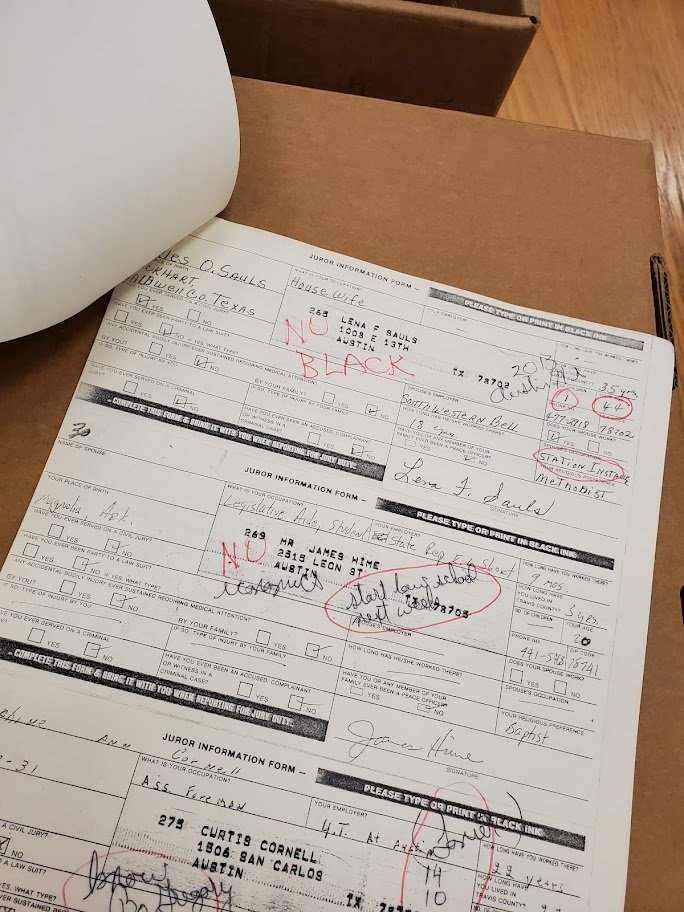Baseball leagues 70 years ago were referred to as "loops," and according to this fascinating 1950 assessment of Texas prison recreation programs, the Texas prison "loop [was] divided into two divisions. Units situated south of the United States Highway 90A play in the southern division, and those north of the highway comprise the northern division."
Team names were as follows. In the southern division: Ramsey 1 Hardhitters; Ramsey 2 Monarchs; Darrington Devils; Retrieve Snippers; Ramsey Builders; and the Clemens Cats (aka "Panthers"). The northern division consisted of the Eastham Buffs; Wynne Cobblers; Walls Tigers; Walls Black Tigers; Central 2 Cubs; and the Harlem 1 Red Socks. N.b. that the Walls Unit had segregated squads.
Occasionally, perhaps ringers would come on the scene when some professional athlete would get into trouble.
Teams played a series with each other team in the division, and the two with the highest winning percentages were declared pennant winners, earning them the right to face off against each other in an end-of-season, 3-game championship series. Sometimes, papers would even publish box scores of the games.Among the league rules: "an escape by any member of a baseball group during the season of the sport can bring suspension of the entire ball club for the remaining season."
It appears prison baseball existed in Texas even earlier, but the league/pennant format was created in 1949. Staples found reference to the Walls Tigers Cyclones* from 1930. In the first half of the twentieth century, prison baseball appears fairly widespread. In Wyoming, even death row inmates played on baseball teams.
At the Texas Prison Museum, according to Texas Highways magazine, there is:
a large display case with baseball uniforms, team photographs, and game programs from the prison baseball team, the Huntsville Prison Tigers. Prison officials organized the team and built a ballpark in 1924. The team played area semi-pro teams until they disbanded in 1943, a casualty of budget-tightening during World War II.
We know they didn't disband permanently in 1943 because teams were still active in 1950, but the construction of a prison ballpark in 1924 likely marks the beginning of the program. Corroborating this timing, on Feb. 24, 1924, the Fort Worth Star-Telegram ran a short item titled, "Prisoners seek equipment for baseball team," declaring the Ferguson State prison farm at Midway "has a group of good ball players and will organize a team if the equipment is forthcoming." Donations sought included "Gloves, a catcher's mitt, mask, [and] baseballs," adding that, "When the team is organized it will play amateur and semipro teams in the vicinity of Midway."
According to the 1950-prison-rec-program assessment, wardens could approve exhibition games on Sundays in addition to league-scheduled contests. Some of these were played before free-world crowds. This flyer from 1942 advertised a baseball game between prison-system all stars and the Southern Select, an "All Mexican Team From Houston." Admission was 25 cents and included entertainment by the "Prison Military Band."
In general, recreational activities seemed more widespread and salutary than TDCJ supports now:
The major activities, which are open to all inmates of good behavior, include competitive sports, such as baseball, volleyball, boxing, tennis, and softball; individual physical activities, such as horseshoe pitching and washer pitching; social games, such as checkers, cards, and dominoes; recreational reading; an annual rodeo; musical activities, including; a weekly radio broadcast; crafts; and motion pictures.
The inmates were leading 5-1 in the 9th inning when all hell broke loose. Suddenly and without warning, gunfire came from the over the walls of the prison. It sounded like a war had begun. Guards yelled and threatened the convicts to hit the ground. All inmates went belly down immediately. But in the stands it was pandaemonium. Everyone there scattered wildly in all directions away from the Walls.
These days, Texas prisons are so understaffed, prisoners are lucky if they get an hour in the rec yard: during COVID lockdowns, they often didn't even get that. They're not playing tennis, much less traveling the state to play baseball in front of paying, free-world crowds.
Still, it's also not like Texas was spending lavishly on prisoners in 1950. From the same report:
Texas taxpayers are getting off very lightly in the operation of the prison. Only two states in the Union spend less per man: Mississippi and Alabama. Texas spends about $310 per year per inmate. Many states spend more than $1,000 per man, while Connecticut tops the list with $1,468 spent on each prisoner in custody.
It's often said that budgets are values documents, and that applies here: Texas wasn't spending much on prisoners, but of what they spent, the state clearly prioritized recreation activities and prisoner well being more than today. The MLB Hall of Fame has a web page on "Baseball Behind Bars" describing early teams at Sing Sing in New York, and its conclusion sums up the values that might prioritize spending tax dollars to create sports leagues for prisoners:
It might be easier to write off all of this coverage of prison baseball as media exploitation, but there is something to be said for the real, positive difference baseball made in the lives of the inmates who played on teams and in leagues while they served out their sentences. The Sing Sing baseball program received praise for the “spiritual change in the men” from the likes of Dr. Katharine B. Davis, the Commissioner of Correction of New York City in 1915. Baseball might be “just a game,” but as any fan knows, it is also one of the things that makes life enjoyable.
*Staples informs me the reference to the prison team he found from 1930 was the Walls "Cyclones," but by 1934, the Tigers were competing. It's possible there were already multiple teams by that time, or that the name changed at some point.


